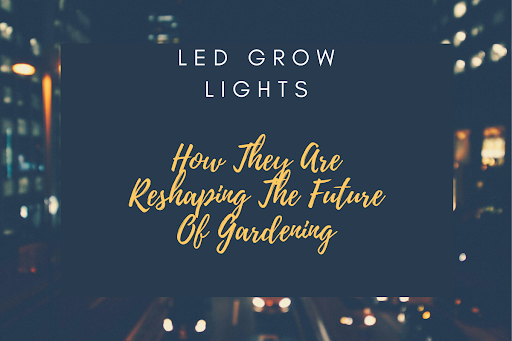 Loading... Please wait...
Loading... Please wait...Save Money. Grow Your Own!
Fast Plain Box Shipping.
We ship to the US & Canada.
Grow Your Own!
LED Grow Lights - How They Are Reshaping The Future Of Gardening
Posted on 25th Jan 2023

Compared to traditional styles of grow lights, LED lights offer the grower many advantages, including decreased operating costs and increased efficiency. LED (light emitting diode) grow lights have taken the horticultural lighting industry by storm for many years. Gardeners and growers who work in Controlled Environment Agriculture (CEA) struggle with the same problems: indoor horticultural lighting is usually big and bulky, and they require massive amounts of electricity to operate.
It's important to note that they simultaneously require cooling as well. The results are high electricity costs, reduced space in the grow area, and requiring more equipment like air conditioners. The LED grow lights introduction to the horticulture community and gardening services were involved in the creation of more advanced technology that helped solve a lot of problems mentioned above. In this article, we will tell you all you need to know about LED grow lights and how they are actively reshaping the future of agriculture and gardening.
Brief History
LEDs were first introduced in 1961 and were extremely costly at the time. The uses of LEDs were limited to being highly specified lab equipment. Early LEDs only emitted light in the infrared spectrum, which was the reason behind their high cost. They were later recognized for their potential during the 1970s, when the production of semiconductor chips became common. This was a huge leap in lighting technology, and it resulted in a drastic reduction of costs while simultaneously increasing the regularity at which LEDs were being made.
During the early 2000s, developers made LED lights capable of producing broad light spectrums, which allowed the down-conversion of blue LED light through phosphor blends and thus produced visible spectrum LEDs. At that point, the application of this new technology started to become widespread and was no longer limited to laboratories and machines. They gradually made their way into television and computer displays. By late 2000 they began to replace fluorescent bulbs for home and commercial lighting. During this time, indoor growers and gardeners began to wonder about the various potential advantages of LEDs.
Advantages of LED grow lights
Indoor Gardening
If you live in an urban city and wish to adopt the hobby of gardening, LED grow lights make it easier to do just that. It's no longer difficult for people, especially urbanized ones, to have indoor plantations. You can use LED lights either as the main source of light in your garden or as a supplement. Vertical gardening has become increasingly easier.
Takes Less space
Traditional grow lights take up lots of space in your garden, leaving you less room for your plantations to grow and flourish. LED lights are compact and come in slim panel designs. They also come with the adaptability to small, limited spaces.
Dimmable
With its dimming controls, you can manage energy wavelengths required according to your plant growths. This feature also helps save electricity when intense light is not needed.
No mercury
LED light fixtures have a longer life span that can go ten or more years, depending on the manufacturer, which means you do not need to regularly change the lightbulbs. Additionally, it is also safe to discard LED light fixtures since they don't contain toxic mercury.
How to use an LED grow light
After research, choose the best type of LED light that is both affordable and beneficial to your cause. If your garden has many plants and the area is spacious, consider using a panel of lights, a large grow lamp, or a reflector for supplemental light to reach the bottom of the leaves. Next comes setting up your lights. The right lighting level depends on the types of plants you keep in your indoor garden. It's important to note that some plants thrive in low-light conditions, and most require bright light, particularly flowering plants, and succulents.
The next step is to keep a good eye on the temperature and monitor your plants. Grow lights are capable of burning house plants depending on the wattage of your light sources. With a low heat output, your LED grow lights can get as close as six inches to the plants without harming them.
Finally, it's important that you keep a timer because a constant light source will deprive the plants of a normal light-dark cycle and may ultimately harm them. A timer will let you regulate the time your plants receive light from the LED grow lights. Your plants need between eight to sixteen hours of light and a minimum of eight hours of darkness.
Wrapping up
LED grow lights have various advantages and reshaping the future of gardening. During 1961 when LED lights were highly costly, they were mainly used as lab equipment or for machinery. Once developers made LED lights capable of producing broad light spectrums, they became more widespread and gradually made their way into television and computer displays. There are many advantages to LED grow lights over traditional grow lights; it's perfect for indoor spaces, there is no toxic mercury, they are dimmable, and take up less space. These advantages can make gardening significantly easier and efficient.
We hope this article has been insightful and has helped you understand LED grow lights. Thank you for reading!
